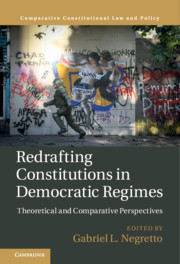Book contents
- Redrafting Constitutions in Democratic Regimes
- Comparative Constitutional Law and Policy
- Redrafting Constitutions in Democratic Regimes
- Copyright page
- Dedication
- Contents
- Tables
- Contributors
- Acknowledgments
- 1 New Constitutions in Democratic Regimes
- Part I Conceptual, Normative, and Empirical Issues
- Part II Case Studies
- Index
- References
1 - New Constitutions in Democratic Regimes
Published online by Cambridge University Press: 29 August 2020
- Redrafting Constitutions in Democratic Regimes
- Comparative Constitutional Law and Policy
- Redrafting Constitutions in Democratic Regimes
- Copyright page
- Dedication
- Contents
- Tables
- Contributors
- Acknowledgments
- 1 New Constitutions in Democratic Regimes
- Part I Conceptual, Normative, and Empirical Issues
- Part II Case Studies
- Index
- References
Summary
Although many contemporary democracies face popular pressures to profoundly transform or replace their constitutions, there is little systematic academic discussion on the legal and political challenges that these events pose to democratic principles and practices. This book is a collaborative effort by legal scholars and political scientists to analyze these challenges from an interdisciplinary and comparative perspective. This introductory chapter discusses the phenomenon of constitutional redrafting in democratic regimes around the world and the contributions each chapter in the book makes to an understanding of the factors leading to the adoption of new constitutions in the context of free and fair elections, the procedural and political features of these episodes, and the relationship between constitutional replacements in democratic regimes, democratic theory, and democratization.
Keywords
- Type
- Chapter
- Information
- Redrafting Constitutions in Democratic RegimesTheoretical and Comparative Perspectives, pp. 1 - 30Publisher: Cambridge University PressPrint publication year: 2020
References
- 1
- Cited by

